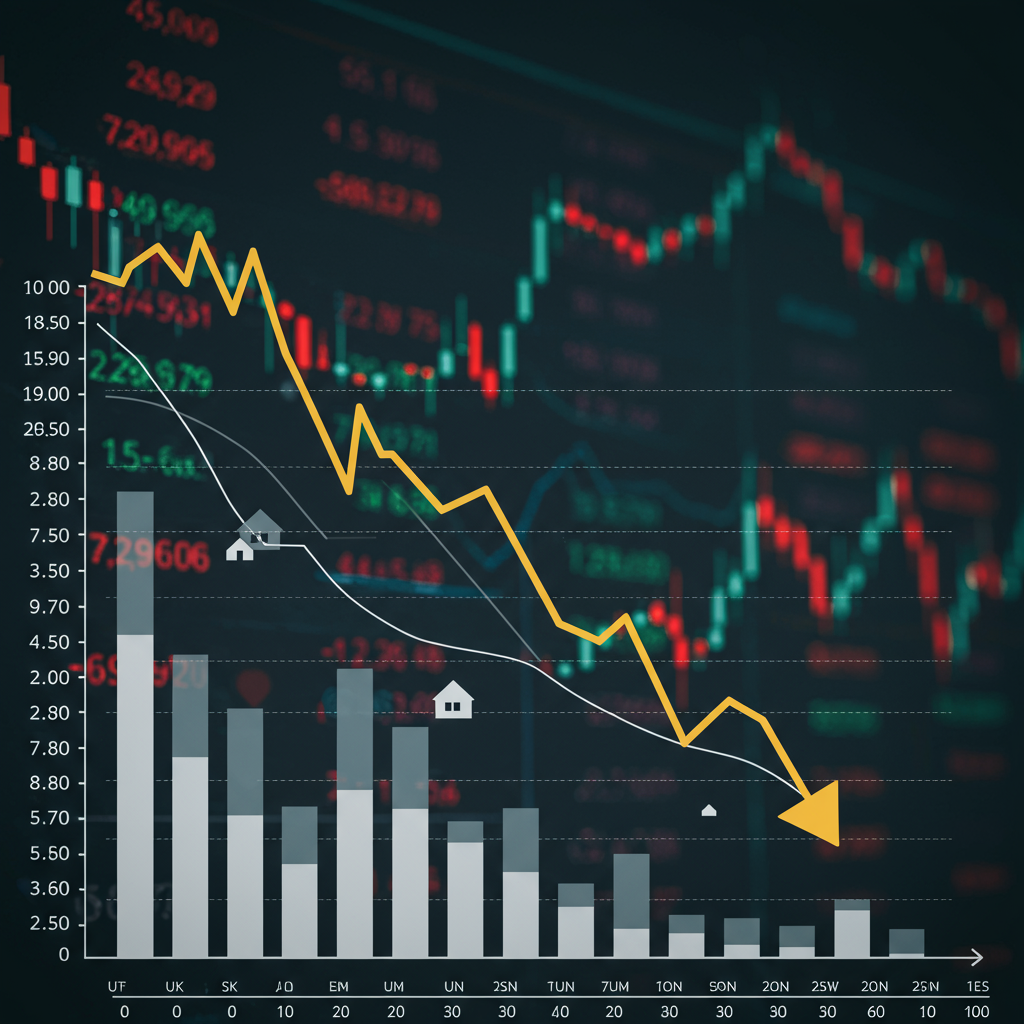US stock markets experienced a sharp decline following former President Donald Trump’s announcement of new <a href="https://news.quantosei.com/2025/07/07/oil-edges-up-as-saudis-bet-market-can-absorb-opec-output-hike/” title=”Expert Analysis: Oil Price Outlook After OPEC+ Output Hike”>tariffs targeting key trading partners, including allies Japan and South Korea. The news triggered significant sell-offs across major indexes, marking the worst day for stocks in approximately three weeks and highlighting renewed investor anxiety over trade tensions.
President Trump utilized his Truth Social platform to unveil a series of letters detailing the upcoming tariffs. Specifically, goods imported from Japan and South Korea are slated to face a 25% tariff starting August 1. Trump cited “longterm, and very persistent” trade deficits with these nations as the primary justification for the move. He also warned that if targeted countries retaliated by imposing tariffs on US goods, an equivalent amount would be added on top of the initial US duty, potentially escalating trade tensions further.
Markets Reel as New Tariffs Hit
The market reaction was immediate and strongly negative. The Dow Jones Industrial Average closed down 422 points, a drop of 0.94%. The S&P 500 index fell 0.79%, while the tech-heavy Nasdaq Composite declined by 0.92%. All three major indexes recorded their poorest performance in about three weeks as investors digested the unexpected tariff news.
The selling intensified midday following the specific announcement of the 25% tariffs on Japan and South Korea. Later in the afternoon, stocks continued their slide as Trump announced tariffs of varying rates, ranging from 25% to 40%, on additional countries including Myanmar, Malaysia, Kazakhstan, Laos, and South Africa. The letters posted by Trump indicated that these rates could potentially be adjusted “upward or downward” based on future relationships.
Sector-Specific Impacts and Broader Market Trends
Certain sectors with significant exposure to the targeted regions saw particularly sharp declines. US-listed shares of major Japanese automakers were hit hard, with Toyota dropping 4%, Nissan falling 7.16%, and Honda decreasing 3.86%. Similarly, US-listed shares of prominent South Korean technology firms suffered losses, as LG Display fell 8.3% and SK Telecom was down 7.76%. Exchange-traded funds (ETFs) managed by BlackRock tracking stocks in Japan, South Korea, South Africa, and Malaysia also saw notable drops, posting their worst day since early April in some cases.
The impact extended beyond equities. US government bonds also slid, causing yields to rise as investors adjusted positions. The yield on the 10-year Treasury increased to 4.39%, and the 30-year yield climbed to 4.92%. In currency markets, the US dollar strengthened significantly against the currencies of targeted nations. The Japanese yen, South Korean won, and South African rand all weakened against the surging dollar. Wall Street’s main measure of market fear, the CBOE Volatility Index (VIX), jumped 8.4%, reflecting heightened uncertainty.
Context and Expert Outlook on Trade Policy
The tariff announcement came amidst a recent rally in US stocks, which had seen the S&P 500 notch several record highs. This optimism was partly fueled by stronger-than-expected economic data and cautious hope that the worst of the trade policy uncertainty was fading, especially as a previous self-imposed deadline of July 9 for various trade deals approached.
However, the new tariffs, particularly the 25% rate on major allies like Japan and South Korea, appeared higher than many market participants had anticipated. Ross Mayfield, an investment strategist at Baird, commented that these proposed rates surprised the market, leading directly to the sell-off.
The initial July 9 deadline for potential tariffs, which followed a 90-day pause initiated in April, has now been formally pushed back to August 1. White House Press Secretary Karoline Leavitt confirmed President Trump would sign an executive order to formalize this new timeline, allowing additional time for negotiations.
Differing Views Amidst Fluid Situation
Market analysts offered mixed interpretations of the developments. Mohit Kumar, chief strategist and economist for Europe at Jefferies, suggested the letters aim to incentivize quick deals. He believes the near-term uncertainty could prompt some profit-taking but ultimately expects more trade deals to be signed. Kumar even proposed that a dip in stocks resulting from this news should be viewed as a potential buying opportunity for investors.
In contrast, others warned against complacency. Scott Wren, global market strategist at Wells Fargo Investment Institute, expressed concern that the consensus view on the tariff outlook might be “overly optimistic.” He highlighted risks that escalating tariffs could slow the economy and potentially impact consumer spending. Wren suggested trimming positions in what he views as overvalued markets and sectors.
Treasury Secretary Scott Bessent indicated that the administration expected a busy period with more trade announcements forthcoming. He told CNBC that he anticipated “several announcements in the next 48 hours,” confirming the August 1 date as the point where tariffs would “boomerang” higher if deals weren’t completed. Experts universally agree, as Jim Baird of Plante Moran Financial Advisors put it, the situation remains “very fluid and can change with very little notice.”
Broader Implications and Negotiation Status
Beyond the specific country tariffs, President Trump also announced a separate threat: an additional 10% tariff on any countries aligning with the BRICS economic bloc (Brazil, Russia, India, China, South Africa), which had recently criticized unilateral tariff actions. This highlights the use of tariffs not just as a trade tool but also for diplomatic leverage.
Progress on previous trade deal goals has been limited. While the administration had aimed to complete roughly 90 deals within the 90-day pause period, only agreements with the United Kingdom and Vietnam have been solidified so far. A framework accord with China was also reached. Negotiations are reportedly ongoing with other key partners like the European Union, Canada, and India, though their outcomes remain uncertain ahead of the August 1 deadline. Reports suggest companies are exploring options like utilizing US-based Foreign Trade Zones to potentially mitigate tariff impacts.
The Federal Reserve is also watching closely. Chair Jerome Powell has indicated the central bank is assessing the potential effects of tariffs on the economy and inflation before making decisions on future interest rate adjustments. Higher tariffs could potentially lead to price increases, a factor the Fed must consider in its monetary policy decisions.
Frequently Asked Questions
What were the specific tariffs announced by Trump and which countries were affected?
President Trump announced new tariffs through letters posted on Truth Social. Key announcements included a 25% tariff on goods from Japan and South Korea. Additional tariffs ranging from 25% to 40% were announced for countries including South Africa (30%), Malaysia (25%), Myanmar (40%), Laos (40%), and Kazakhstan (25%), among others. These tariffs are set to go into effect on August 1, 2025.
How did the stock market react to Trump’s new tariff announcements?
US stock markets reacted negatively, experiencing significant drops across major indexes. The Dow Jones Industrial Average fell by 0.94%, the S&P 500 by 0.79%, and the Nasdaq Composite by 0.92%. This marked the worst trading day for these indexes in approximately three weeks. Shares of companies and ETFs with exposure to the targeted countries, particularly in automotive and technology sectors, also saw substantial declines.
When will these new tariffs take effect, and what is the status of related trade negotiations?
The new tariffs announced by President Trump are scheduled to take effect on August 1, 2025. This date was formalized by an executive order, pushing back a previously discussed deadline of July 9. The administration had aimed to complete numerous trade deals, but only agreements with the UK and Vietnam have been finalized thus far, along with a framework with China. Negotiations continue with other countries ahead of the August 1 deadline.
Conclusion
The latest announcement of new tariffs by President Trump has injected significant uncertainty back into the global markets, abruptly halting a recent period of optimism. The sharp decline in US stocks reflects investor concerns about the potential economic impact of these protectionist measures, particularly the unexpected rates applied to major allies. As the August 1 deadline approaches and trade negotiations continue, market participants will be closely watching for further developments, which experts suggest could arrive with little advance notice, keeping volatility elevated.



